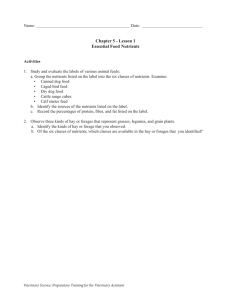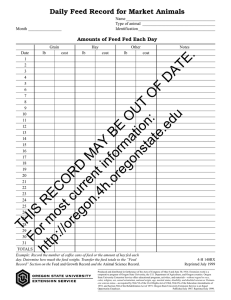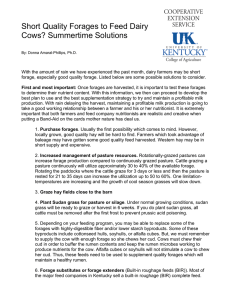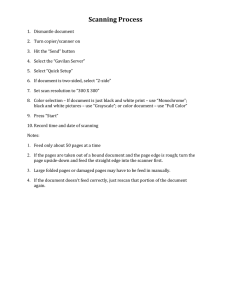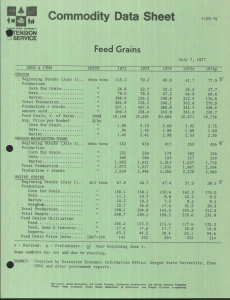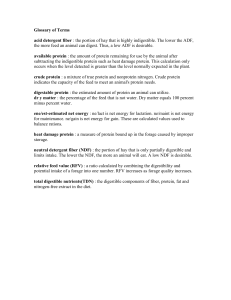Equine Feeds & Feeding
advertisement
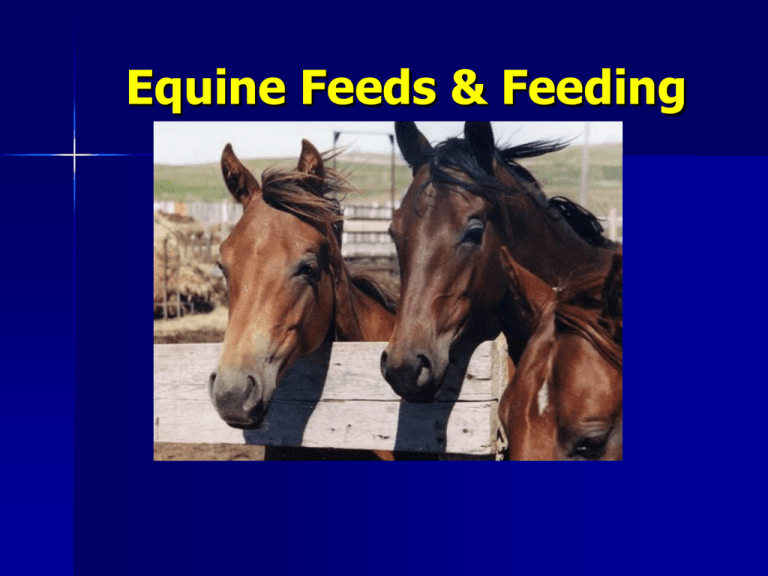
Equine Feeds & Feeding Building a Horse Ration Start with horse needs Maximize forage Add energy if needed Add protein and minerals if needed Consider adding vitamins and supplements Feed concentrate that makes-up the difference between nutrients needed & nutrients in roughage HAY OR PASTURE Foundation for every feeding program. – Adequate chewing time – Energy – Aids in proper transit thorough GI tract – Main substrate for bacterial digestion in the cecum – Indigestible parts provide scratch factors – prevent wood chewing What is forage? Min. fiber content of 18% & relatively low dietary energy Cell walls – cellulose, hemi cellulose, lignin (0% digested) Cell contents – protein, soluble carbohydrates, ether extract, ash Forages Grass – Bromegrass – Orchardgrass – Tall Fescue – Timothy Grain Hay – Oat Hay – Wheat hay Straw Legume – Alfalfa – Birds Foot trefoil – Clovers – Lespedeza Hays Nutritive Value & Palatability Plant species Level of maturity at harvest Weed content Growing conditions Curing & harvesting conditions Hays Nutritive Value & Palatability Soil conditions & fertility Moisture content Length & method of storage Supplement Energy? Concentrates often needed – Late gestation – Lactation – Growth – Work Energy Sources Comparative Values Grain DE (Mcal/lb) Relative Feeding Value by volume (%) CP (%) Crude Fiber (%) Comments Oats (regular) 1.3 45 11-12 11 Most palatable & safest. Variable in quality Oats (heavy) 1.4 50 12.5 11 Also called “racehorse” or “jockey” oats Groats (hullless oats) 1.7 95 18 2.1 Corn (maize) 1.5 100 8-10 2.2 Grain most prone to mold & most commonly overfed Energy Sources Comparative Values Grain DE (Mcal/lb) Relative Feeding Value by volume (%) CP (%) Crude Fiber (%) Comments Barley 1.5 85 12 5 Between oats & corn in safety, but less palatable. Grain sorghum (milo) 1.45 95 11.5 2.5 Wheat 1.55 110 11-14 1.5-3 Rye 1.53 100 12 2.2 Fats 3.61 -- -- Should be processed. Less palatable then corn or oats. Should be processed. Feed processed, with 1/3 max. in grain mix. Crude Fiber & DE Relation of Commonly Fed Feeds Feedstuff DE (Mcal/lb) CF (%) Corn 1.5 2 Wheat Mids 1.4 7 Oats 1.3 12 Soybean Hulls 1.1 32 Alfalfa Hay 1.0 20 Relationship of Crude Fiber to Expected DE If the feed tag indicates CF (%) of Then, DE (Mcal/lb) But if the feed of the feed will be ~ contains 5% added fat, the DE (Mcal/lb) will be ~ 4 1.55 1.65 6 1.45 1.55 8 1.35 1.45 10 1.25 1.35 12 1.15 1.25 Protein Needed for: muscle & bone growth, milk production, fetal growth, normal metabolism Requirements can be met with good quality hay or pasture forage Low requirements for maintenance Quality = amino acid balance – Very important for young horses – Lysine, methionine, tryptophan most limiting for growth & milk production Comparison Protein Supplements Feed CP (%) Lysine (%) Soybean meal 44 .87 Linseed meal (flax) Dried skim milk 34 .16 33 .54 Minerals Content in the diet will be determined by soil & water in area Quality of feed and proportion of grain to hay Ca and P – – – – – Continuous loss 70% of the mineral content of the body 99% of the Ca and 80% of the P in bones and teeth 1.1—2.0 parts Ca to 1.0 part P is ideal Quality forages usually provide adequate Ca & P Minerals Salt (NaCl) – – – – .5-1.0% added ~ 60 g/d Free choice Either in block form or loose Potassium, Magnesium, Sulfur – Supplement as a group - use one quantities are additive toxicities possible – Keep in the proper ratios Trace Minerals Look for iron, zinc, copper Ratios affect absorption of all Toxicities often seen with iron and selenium Adequate Minerals Mineral Maintenance Pregnant & Lactating Growing Work Max. Sodium (%) .10 .10 .10 .30 Sulfur (%) .15 .15 .15 .15 3.0 (NaCl) 1.25 Iron (mg/kg) 40 50 50 40 1,000 Manganese 40 40 40 40 1,000 (mg/kg) Zinc (mg/kg) 40 40-60 40-60 40 500 Copper (mg/kg) 10 15-30 20-30 10 800 Iodine (mg/kg) 0.1 0.1 0.1 0.1 5.0 Selenium 0.1 0.1 0.1 0.1 2.0 0.1 0.1 0.1 0.1 10 (mg/kg) Cobalt (mg/kg) Trace Mineralized Salt 98% sodium chloride Zn – 0.1-0.35% Manganese – 0.20-0.28% Iron – 0.15-0.35% Copper – 0.02-0.04% Cobalt – 0.05-0.007% Iodine – 0.007% TMS containing high levels of Cu (0.25%), Zinc (0.75%) and/or selenium (0.0025%) is available. Vitamins Fat soluble: - stored in body - A, D, E, K - Toxicity’s can occur if fed in excess Water soluble: - must be continuously supplied - B-complex; niacin, thiamin, riboflavin Adequate Vitamins Vitamin Maintenance Growing Work Max. 2,000 Pregnant & Lactating 3,000 2,000 2,000 16,000 300 600 800 300 2,200 50-80 80-100 80-100 80-100 1,000 Thiamin (ppm) 3 3 3 5 3,000 Riboflavin 2 2 2 2 Vit. A (IU/kg DM) Vit D (IU/kg DM) Vit E (IU/kg DM) (ppm) •High quality fresh forages = maintenance for mature horses •Hay is poor in Vit A. Supplement Vit A in the ration •Exposure to sunlight provides Vit D •Vit. E is important for reproduction, performance horses, prevention of white muscle disease, equine degenerative myeloencephalopathy (EDM), and equine motor neuron disease (EMND) •Vit B is synthesized in the horse’s cecum Vitamin/ Mineral Combinations A, D, E, & K - Stored in fat - potentially toxic C, B complex - water soluble Blood builders - mostly iron Vitamins easily destroyed by heat, copper and iron, dampness, and high oil levels Biotin/methionine - sulfur - hoof growth Feeding Horses Feed intake usually expressed as % of Body Weight Lbs feed/100 lbs body weight Free Choice Min. 1% BW as forage Grains provide 50%-60% more DE than forage Vegetable oils & animal fats provide 2.25x more energy then grain No more than 10-15% of total diet Expected feed consumption %BW Forage Concentrate Total Maintenance 1.5-2.0 0-0.5 1.5-2.0 Mares, late gestation 1.0-1.5 0.5-1.0 1.5-2.0 Mares, early lactation 1.0-2.0 1.0-2.0 2.0-3.0 Mares, late lactation 1.0-2.0 0.5-1.5 2.0-2.5 Light work 1.0-2.0 0.5-1.0 1.5-2.5 Moderate work 1.0-2.0 0.75-1.5 1.75-2.5 Intense work 0.75-1.5 1.0-2.0 2.0-3.0 Nursing foal, 3 mo 0.5-1.0 1.0-2.0 2.5-3.5 Weanling foal, 6 mo 0.5-1.0 1.5-3.0 2.0-3.5 Yearling foal, 12 mo 1.0-1.5 1.0-2.0 2.0-3.0 Long yearling, 18 mo 1.0-1.5 1.0-1.5 2.0-2.5 Two year old 1.0-1.5 1.0-1.5 1.75-2.5 Remember… Make educated decisions Feed by weight not by volume All feed should be clean of mold, dust, etc. Feed at regular intervals – ~12 hours Make gradual changes in feeding program – “Safer” to increase hay then grain
